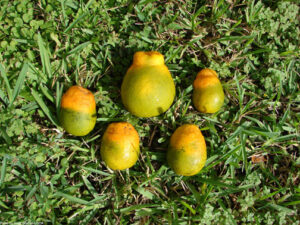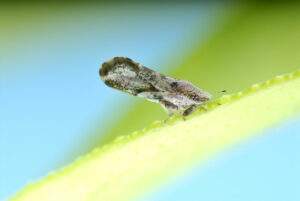Written by Stephen Cohen, a 2017-2018 Sustainability Leadership Fellow and Ph.D. Candidate in the Department of Bioagricultural Sciences and Pest Management
What’s more American than a glass of orange juice in the morning? Last year, over 47 million boxes of Valencia oranges were produced in the United States [1], but this fundamental part of American breakfast is in danger of disappearing.
Huanglongbing (HLB), also known as citrus greening, is a disease of citrus trees that is wreaking havoc on worldwide production of oranges, grapefruits, lemons, limes, and more. Once infected, a tree will begin to produce green, oddly-shaped and bitter fruits before ultimately dying within five years. This incurable plant disease is caused by the bacterial pathogen Candidatus Liberibacter asiaticus, which is spread from tree to tree by insects called Asian citrus psyllids. These tiny jumping insects are invasive to North America.
 HLB first appeared in the U.S. in 2005, when infections were detected in Florida orange groves. The disease spread, resulting in at least $4 billion of economic damage and the loss of 8,000 jobs over the ten years that followed. By today, HLB has been detected in most U.S. citrus growing regions, including California, Georgia, Louisiana, Puerto Rico, South Carolina, Texas, the U.S. Virgin Islands, and all citrus-growing counties in Florida.
HLB first appeared in the U.S. in 2005, when infections were detected in Florida orange groves. The disease spread, resulting in at least $4 billion of economic damage and the loss of 8,000 jobs over the ten years that followed. By today, HLB has been detected in most U.S. citrus growing regions, including California, Georgia, Louisiana, Puerto Rico, South Carolina, Texas, the U.S. Virgin Islands, and all citrus-growing counties in Florida.
The economic toll of the HLB outbreak has been devastating. In Florida, which is in the top three global regions for growing juice oranges, nearly all orange growing counties have lost oranges due to HLB [2]. HLB is not the only factor influencing orange production losses, but many experts speculate that it is the single greatest factor that has influenced the greater than 70% decline in Florida’s orange production over the last 12 years.
Since HLB is incurable, the recommended disease management solution is to prevent its spread by killing the insects that transmit it. To wipe out the psyllids, citrus growers use aggressive and repeated sprays of insecticide cocktails, but this solution is neither safe nor sustainable. Overuse of insecticides may present a health risk to orchard workers and consumers, while also allowing the insects to adapt to overcome insecticide treatments. For this approach to be effective, abandoned citrus groves would also have to be destroyed or treated, since both the bacteria and insects can survive on dying plants. However, treating abandoned orchards can be a total economic loss for farmers – so who would cover the expense?
In addition to insecticides, citrus growers are using other strategies to control the disease. Plastic enclosures called isolation tents protect trees from insects and raise the temperature to slow disease progression. Because HLB infection disrupts plant nutrient uptake, enriching the soil with extra nutrients prolongs the lives of trees. Limited trials have been approved for treating orchards with antibiotics. These solutions are only effective in the short-term, and no permanent solution has been found. As a result, many Florida farmers are switching from growing oranges to alternative crops, which is further contributing to the loss of juice orange production.
Many scientists are now advocating the use of biotechnology solutions, including the production of genetically modified (GM) trees, to solve the HLB crisis. For example, using transgenic technologies, a team of researchers at the University of Florida produced GM orange trees that were immune to HLB [3]. After three years, these trees remained disease-free, even when planted in areas with unmanageable levels of the disease.
 While biotechnologies are helping scientists quickly develop efficient solutions to control HLB, the greatest challenge to widespread adoption of these technologies may be consumer acceptance. Historically, U.S. consumers are wary of GM foods, and there has been pushback against them. And in a recent survey of Florida citrus growers about the prospect of growing GM trees, the growers’ biggest concern was consumer reactions [4].
While biotechnologies are helping scientists quickly develop efficient solutions to control HLB, the greatest challenge to widespread adoption of these technologies may be consumer acceptance. Historically, U.S. consumers are wary of GM foods, and there has been pushback against them. And in a recent survey of Florida citrus growers about the prospect of growing GM trees, the growers’ biggest concern was consumer reactions [4].
How will consumers react to the disappearance of the nation’s supply of homegrown oranges? Because the use of biotechnology is producing real, long-term solutions to HLB, perhaps the stubbornness to accept GM foods may decline in the face of rising cost and rarity of the nation’s supply of homegrown oranges disappearing. After all, can we live without our morning orange juice?
References
- United States Department of Agriculture National Agriculture Statistics Service. 2018. https://www.nass.usda.gov. Accessed: January 2018.
- Neupane D, Moss CB, van Bruggen AH. Estimating citrus production loss due to citrus huanglongbing in Florida. 2016 Annual Meeting, Southern Agricultural Economics Association. In: 2016 Annual Meeting, Southern Agricultural Economics Association, 6-9 February 2016, San Antonio, TX.
- Dutt M, Barthe G, Irey M, Grosser J. Transgenic Citrus Expressing an Arabidopsis NPR1 Gene Exhibit Enhanced Resistance against Huanglongbing (HLB; Citrus Greening). PLoS ONE. 2015;10(9): e0137134.
- Singerman A, Useche P. Florida Citrus Growers’ First Impressions on Genetically Modified Trees. AgBioForum. 2017;20(1):67-83.





